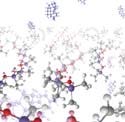Silicone Supplier Publishes Drug-Delivery Market Summary
October 8, 2004
Originally Published MPMN October 2004
INDUSTRY NEWS
Silicone Supplier Publishes Drug-Delivery Market Summary
|
A market report published by NuSil Technology takes an in-depth look at silicone-based drug-delivery products. Pictured is a graphical representation of estradiol molecules releasing from a polydimethylsiloxane surface (click to enlarge). |
Designed to assist developers of drug-delivery products that incorporate silicone, a market report describes types of devices in which the material may be used along with compatible pharmaceutical agents. NuSil Technology (Carpinteria, CA; www.nusil.com) has made the report available to existing and potential customers on its Web site. An on-line request form can be accessed at www.nusil.com/literature.
The summary begins with an overview of current drug-delivery devices that use silicone. Implanted, mucosal, and transdermal products are included. The report continues with a section on materials selection that lists NuSil materials and their corresponding applications. Candidate drugs such as antidepressants, vitamins, and antiviral and other agents suitable for incorporation into silicone-based drug-delivery devices are compiled. Reference materials and patent data are also included.
The company has also announced an expansion of its Carpinteria plant. A new 70,000-sq-ft facility will extend the firm’s shipping and packaging departments and its warehouse. It will also enable expansion of its manufacturing capabilities. The company’s existing 160,000-sq-ft plant is devoted primarily to R&D and manufacturing. Construction is expected to be completed by the end of 2004.
Certified to ISO 9001, NuSil Technology specializes in the formulation and application of silicone materials for the healthcare and other industries. The firm recently introduced pigmented master batches for liquid silicone rubber formulations meeting USP Class VI testing requirements.
“Adding powder-based pigments such as titanium dioxide or barium sulfate to silicone systems can be a messy and inaccurate process,” says Brian Nash, vice president of marketing and sales. Adding pigment to functional polymers creates a “user-friendly solid/liquid mass that can be easily added to elastomers,” he explains.
The pigmented master batches are available in unrestricted and restricted versions. Unrestricted formulations may be considered for use in long-term implantable applications; restricted materials are suited for short-term implantable (<30 days) or external use. Their consistency is similar to many types of liquid silicone rubber. Containing 50% barium sulfate or 50% titanium dioxide by weight, they are designed to be pumped by a third line into a liquid-injection molder’s dynamic mixing chamber. The materials can also be added manually for compression molding.
Copyright ©2004 Medical Product Manufacturing News
You May Also Like



